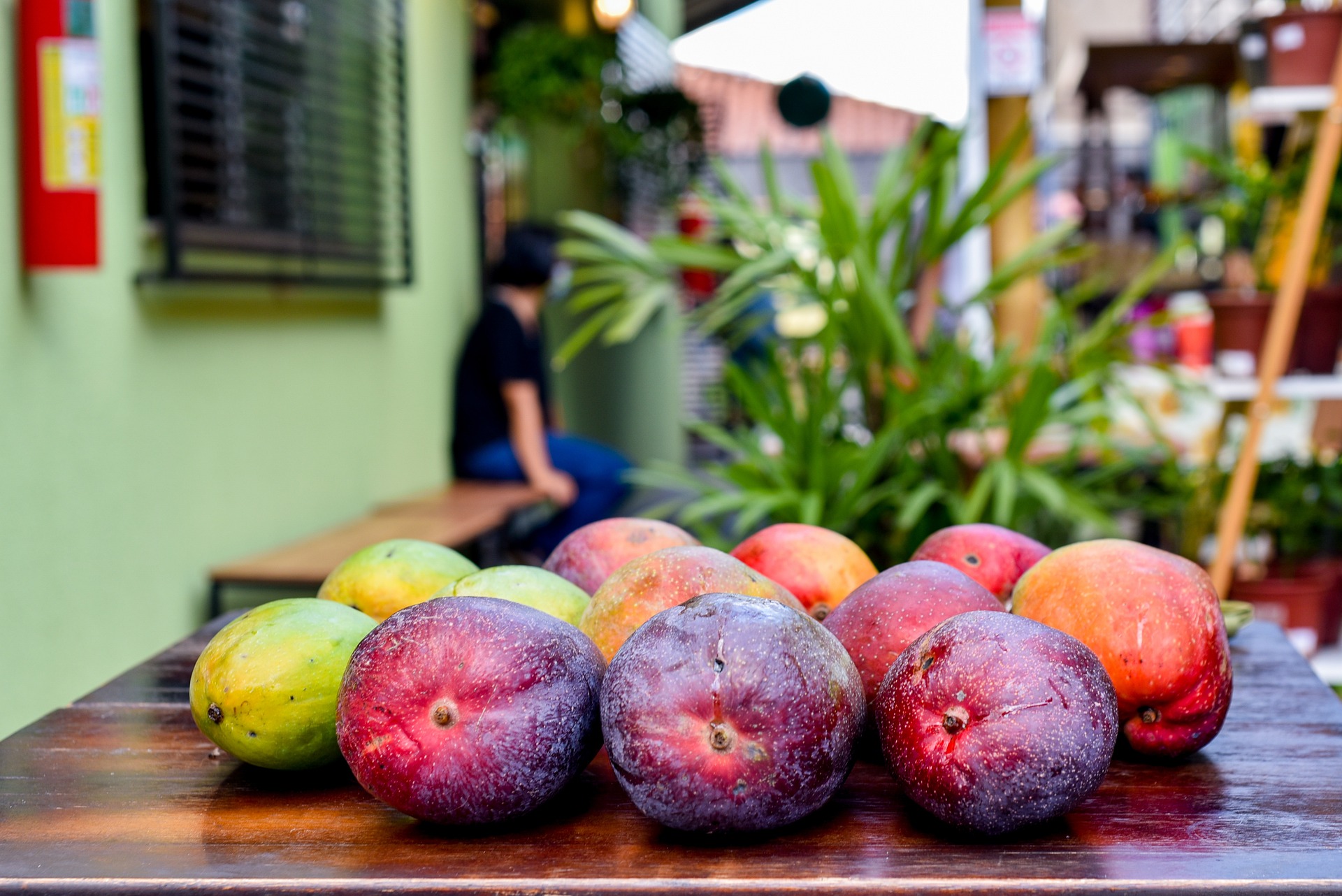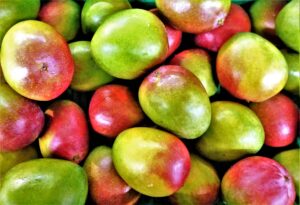As the mango season is almost here everyone is looking forward to take a bite of the delicious king of fruits. But if you are buying mangoes right now, you might find the unripe ones. There are many varieties of mangoes available and you might not be able to choose the perfect one. Today we will find out how to tell if a mango is ripe so that you munch on the sweet ones only.
Table of Contents
How to tell if a mango is ripe
Mangoes are available in different shapes, sizes, colors, and varieties but how to tell if a mango is ripe? This could be tough to differentiate if you never went mango shopping. No matter what type it is, the below tips will help you find the ripe ones immediately:
Touch and texture
Take the mangoes and start pressing them gently and see if it is slightly soft. But if it is firm, the mangoes need more time to ripen.
The look
Green ones are mostly unripe, which you can use for dressing, pickles, salsa, or as an appetizer. But if you go for Tommy Atkins, this variety has green with red blush on it.
Without the red, it is an unripe one. Hence check for the red blush. Also, the ripe mango has protruding stalk, which reflects juicy flesh.
Ripe mangoes may also have intense colors ranging between yellow to orange and even red.
Sweet smell
A nice ripe mango will smell like a ripe melon. Unripe mangoes do not have a smell. If you love mangoes, you already know the irresistible sweet smell of ripe mangoes.
Juicy stem
Ripe mangoes will have a juicy stem. Check out the mango’s stem to see if it’s oozing any juice. This may not be the case for all ripe ones.
Look for freckles
It might sound funny to find freckles on your mangoes, but it’s a fact. You need to look for brown or white spots, which indicate ripeness. The freckles show up only when the fruit becomes sweet from the inside.
Heaviness
A ripe mango will always be heavier than the unripe one. This is one of the easiest indicators of a ripe and juicy mango.
How to tell if a mango is ripe depending on variety
You already know the basics of how to tell if a mango is ripe. But now, there are numerous varieties of mangoes available that will have different indicators. However, the most common indicators are the shape and weight of the mangoes. The mango will be heavy and oval in shape if it is ripe.
Now let’s see how to tell if a mango is ripe depending on various types:
The Francis mango
When ripe, this type of mango will have an oblong and look like the S-shape.
The Ataulfo mango
This variety is usually small with an oval flattened shape when it ripens.
The Keitt mango
These are usually bigger, and the shapes become oval as they ripen.
The Haden mango
This one may be round or oval in shape and are medium in size as it ripens.
The Tommy Atkins
These are oblong and large in size when they ripen.
The Kent mango
These are big and oval in shape.
The Edward mango
These are oblong and round in shape when they ripen.
The Alphonso mango
These are oblong in shape and much sweeter compared to other varieties.
The Kesar mango
These are round and have a red tinge on them.
The Palmer mango
This one is elliptical in shape as it ripens.
The Manila mango
These are skinny and slender in shape.
How to ripen mangoes
There might be instances where you buy unripe mangoes at a discount or you buy them by mistake.
Well, you will be happy to find out how to ripen mangoes at home.
Check out the coolest methods to change the course of nature with your hands! Note that these, however, will take time and patience.
So, are you ready?
Let’s start.
Using paper bag
In this method, you just need a paper bag. Put the unripe mangoes in a paper bag and fold the top. Now leave it on your kitchen counter or anywhere at room temperature.
The process produces ethylene which helps ripen the mango. Hence when you put it in the paper bag, you are trapping ethylene and accelerating ripening of the fruit.
Leaving it at room temperature
If you want to ripen the mango without effort, you can leave it on your kitchen top for 2-3 days. If you are not in a hurry, this should be the most apt way to ripen the mangoes as you do not use anything externally. However, an unripe mango can go bad instead of becoming ripened. It will differ from one piece to another.
Microwaving
If you are losing out on patience and can’t wait any further, use the microwave. Cut the mango into slits and put it in the oven for about 20 seconds. You can eat it right away. This method will degrade the quality of a ripe mango. Hence use this method only in urgency. You might not get the desired taste as well but the mango will become soft.
Rice and popcorn
Don’t have a paper bag? Use your rice box!
Earlier, this method was used extensively used. Putting the unripe fruit into a box of uncooked rice or popcorn kernels will do the same thing as releasing ethylene. You need to trap the ethylene gas in the same way as done by the paper bag.
Benefits of eating mangoes
Mangoes are the king of fruits due to its high nutritional value. Here are the top mango benefits that you will receive if you add this to your summer diet:
Works as a protective antioxidant
The chemicals found in mango are mangiferin and gallotannins. These chemicals are said to fight the toxic stress levels in your body.
Helps in digestion
If you have constipation, a nice juicy mango should be your favorite fruit. It has significant symptoms to improve your chronic constipation.
This is because mango is highly rich in fiber.
The mango tree also aids in antidiarrheal activity in your body.
Many researchers have also shown how the fruit’s phytochemicals help reduce inflammation because of its antioxidant and anti-inflammatory properties, making it an excellent fruit for your gut health.
Healthy heart
Did you know that having a mango can aid in maintaining your heart healthy? Mangoes taste great, but they also have fantastic components that reduce stress and help maintain your heart health.
The chemical present in this fruit also suggests that it efficiently balances cholesterol in your body. As you know, low cholesterol indicates a healthy heart.
Healthy eyesight
Mangoes are also great for your eyes. They are filled will carotenoids that help maintain your eye health.
It provides zeaxanthin and lutein that protects the retina from harmful UV rays and other light harmful to the eyes.
With age, your eyes also get affected. However, studies suggest that mangoes help keep eyesight healthy for a more extended period.
Meaning it slow-downs the aging of the eyesight.
Healthy hair and skin
Mangoes are rich in Vitamins A & C, and both play vital roles in your hair and skin health.
How to eat a mango
Now having a mango in its own form is the best way to enjoy the fruit. But if you want this to be added to your dishes, there are a few simple hacks that you can use:
A fruit salad
Adding mangoes to your fruit salad can instantly add life to a boring collection of fruits. It is best to pair with other summer fruits like watermelon and bananas. You can also add a little bit of chaat masala to make your salad have a spicy and tangy side.
Mango with peanut butter
Did you know that mango with peanut butter and white bread toast can taste heavenly. All you need to do is toast up two slices of bread, spread peanut butter on top of each, and add chopped mango pieces all over.
Parfait
This is super easy. Do some layering using low-fat yogurt (could be vanilla, blueberries, or plain), raisins, mangoes, and granola.
Mango Kebabs
Take your skewer out and start adding the mangoes. Roast them up till they start turning brown. Voila! Your mango kebabs are ready.
Mango smoothie
Ready for a yummy refreshing smoothie?
Take a cup of your favorite fruit juice, preferably orange, and add some yogurt, about ½ a cup.
Now blend it along with some bananas and mangoes.
Your mango smoothie is ready. This is one of the perfect summer cooler recipes to try at home.
Mango Puree
The best way to enjoy Mango puree is with vanilla ice cream and some strawberries cut up on top.
Mango Lollies
Freezing up mango puree to make homemade popsicles can quench your thirst for ice-creams while consuming a healthier alternative.
How to store mangoes
Mangoes can be stored using the below methods but only for a certain period of time:
Storing for a few days
The refrigerator will help slowing down the process of ripening, which means the mangoes will stay good for a period. Ripe mangoes can stay good for almost five days in the refrigerator.
You can keep the leftover mangoes in the fridge using an airtight box. This should stay good for almost a week. But when you have it next, ensure you smell them first. If the taste goes bad, you should refrain from consuming them.
Storing for a few months
But if you want to freeze them for a more extended period, say six months, then you need to put in some extra effort. First, peel the mango nicely and cut them into cubes or slices.
The next thing you need is a baking sheet. Place the chopped mangoes on the baking sheet and freeze them for more than two hours or overnight. Ensure you put the pieces nicely, sticking them onto each other.
The following day, take out the frozen pieces and put them in a freezer-safe container or bag. However, a bag is always a better option as it can be tightly sealed without any moisture in it.
Now put the bag in the freezer. You are done. Enjoy the mangoes for six months at the most.
Are you wondering how to defrost it?
Well, just take them out from the freezer at least before 3-4 hours of consumption. But remember, the mango texture or taste will not stay the same as the fresh ones. These mangoes are best used for cocktails, smoothies, and not eaten raw.
Final Thoughts
Now you can quickly identify a ripe mango and enjoy it to your heart’s content. But remember anything in excess is only going to show its side effects. Excess consumption of mangoes can cause gastrointestinal issues like indigestion, diarrhea, and stomach pain. So, do not eat a lot of mangoes this summer but add it to your breakfast meals twice or thrice a week.



